Limiting Wind-Induced Resuspension of Radioactively Contaminated Particles to Enhance First Responder, Early Phase Worker and Public Safety—Part 1
Abstract
:1. Introduction
- Soil2O®1 dust control wetting agent (available in the US);
- Calcium chloride (CaCl2);
- Phos-Chek®MVP-F3 fire retardant (available in the US);
- Locally available firefighting foam;
- Capping with locally available gravel, mulch, sand or clay;
- Misting with water or saltwater (brine), with the possible addition of additives;
- Application of a polymer coating/gel.
2. Materials and Methods
2.1. Soil Sampling and Physicochemical Characterization
2.2. Soil Stabilization
2.2.1. Stabilization Materials
2.2.2. Application of Stabilizers
2.3. Boundary-Layer Wind Tunnel Experiments: Resuspension Testing and Calculations
3. Results
3.1. Physicochemical Characteristics of the Soils
3.2. Effectiveness of Brine Stabilizers on Resuspension Suppression from the Ze’elim Soil
3.3. Effectiveness of Brine Stabilizers on Resuspension Suppression from the Yamin Soil
4. Discussion
Author Contributions
Funding
Institutional Review Board Statement
Informed Consent Statement
Data Availability Statement
Conflicts of Interest
Disclaimer
References
- Argonne National Laboratory. Municipal and Commercial Equipment for Radiological Response and Recovery in an Urban Environment: State of Science, Research Needs, and Evaluation of Implementation towards Critical Infrastructure Resilience; ANL/NE-17/37; Argonne National Laboratory: Lemont, IL, USA, 2018.
- Environmental Protection Agency. Wide Area Stabilization of Radiological Particulate Contamination; EPA/600/R-16/067; U.S. Environmental Protection Agency: Washington, DC, USA, 2017. Available online: https://cfpub.epa.gov/si/si_public_file_download.cfm?p_download_id=530543&Lab=NHSRC (accessed on 25 January 2022).
- Katra, I. Comparison of Diverse Dust Control Products in Wind-Induced Dust Emission from Unpaved Roads. Appl. Sci. 2019, 9, 5204. [Google Scholar] [CrossRef] [Green Version]
- Shao, Y.; Raupach, M.R.; Findlater, P.A. Effect of saltation bombardment on the entrainment of dust by wind. J. Geophys. Res. Atmos. 1993, 98, 12719–12726. [Google Scholar] [CrossRef] [Green Version]
- Swet, N.; Katra, I. Reduction in soil aggregation in response to dust emission processes. Geomorphology 2016, 268, 177–183. [Google Scholar] [CrossRef]
- Environmental Protection Agency. Evaluation of Hydrogel Technologies for the Decontamination of 137Cs from Building Material Surfaces; EPA/600/R-17/035; U.S. Environmental Protection Agency: Washington, DC, USA, 2017. Available online: https://cfpub.epa.gov/si/si_public_file_download.cfm?p_download_id=530777&Lab=NHSRC (accessed on 25 January 2022).
- Environmental Protection Agency. Technical Report for the Demonstration of Wide Area Radiological Decontamination and Mitigation Technologies for Building Structures and Vehicles; EPA/600/R-16/019; U.S. Environmental Protection Agency: Washington, DC, USA, 2016. Available online: https://cfpub.epa.gov/si/si_public_file_download.cfm?p_download_id=529008&Lab=NHSRC (accessed on 25 January 2022).
- Bustos, M.; Cordo, O.; Girardi, P.; Pereyra, M. Evaluation of the Use of Magnesium Chloride for Surface Stabilization and Dust Control on Unpaved Roads. Transp. Res. Rec. 2015, 2473, 13–22. [Google Scholar] [CrossRef]
- Gonzalez, A.; Aitken, D.; Heitzer, C.; Lopez, C.; Gonzalez, M. Reducing mine water use in arid areas through the use of a byproduct road dust suppressant. J. Clean. Prod. 2019, 230, 46–54. [Google Scholar] [CrossRef]
- Ben-Hur, M.; Cohen, R.; Danon, M.; Nachshon, U.; Katra, I. Evaluation of groundwater salinization risk following application of anti-dust emission solutions on unpaved roads in arid and semiarid regions. App. Sci. 2021, 11, 1771. [Google Scholar] [CrossRef]
- Katra, I.; Laor, S.; Swet, N.; Kushmaro, A.; Ben-Dov, A. Shifting cyanobacterial diversity in response to agricultural soils associated with dust emission. Land Degrad Dev. 2017, 28, 878–886. [Google Scholar] [CrossRef]
- Edri, A.; Dody, A.; Tanner, S.; Swet, N.; Katra, I. Variations in dust-related PM10 emission from an arid land due to surface composition and topsoil disturbance. Arab J. Geosci 2016, 9, 607. [Google Scholar] [CrossRef]
- Katra, I.; Elperin, T.; Fominykh, A.; Krasovitov, B.; Yizhaq, H. Modeling of particulate matter transport in atmospheric boundary layer following dust emission from source areas. Aeolian Res. 2016, 20, 147–156. [Google Scholar] [CrossRef]
- Swet, N.; Elperin, T.; Kok, J.; Martin, R.; Yizhaq, H.; Katra, I. Can active sands generate dust particles by wind-induced processes? Earth Planet. Sci. Lett. 2019, 506, 371–380. [Google Scholar] [CrossRef] [Green Version]
- Magnuson, M.; Stilman, T.; Serre, S.; Archer, J.; James, R.; Xia, X.; Lawrence, M.; Raveh-Amit, H.; Sharon, A. Stabilization/Containment of Radiological Particle Contamination to Enhance First Responder, Early Phase Worker, and Public Safety—Part 2. Appl. Sci. 2022. submitted. [Google Scholar]


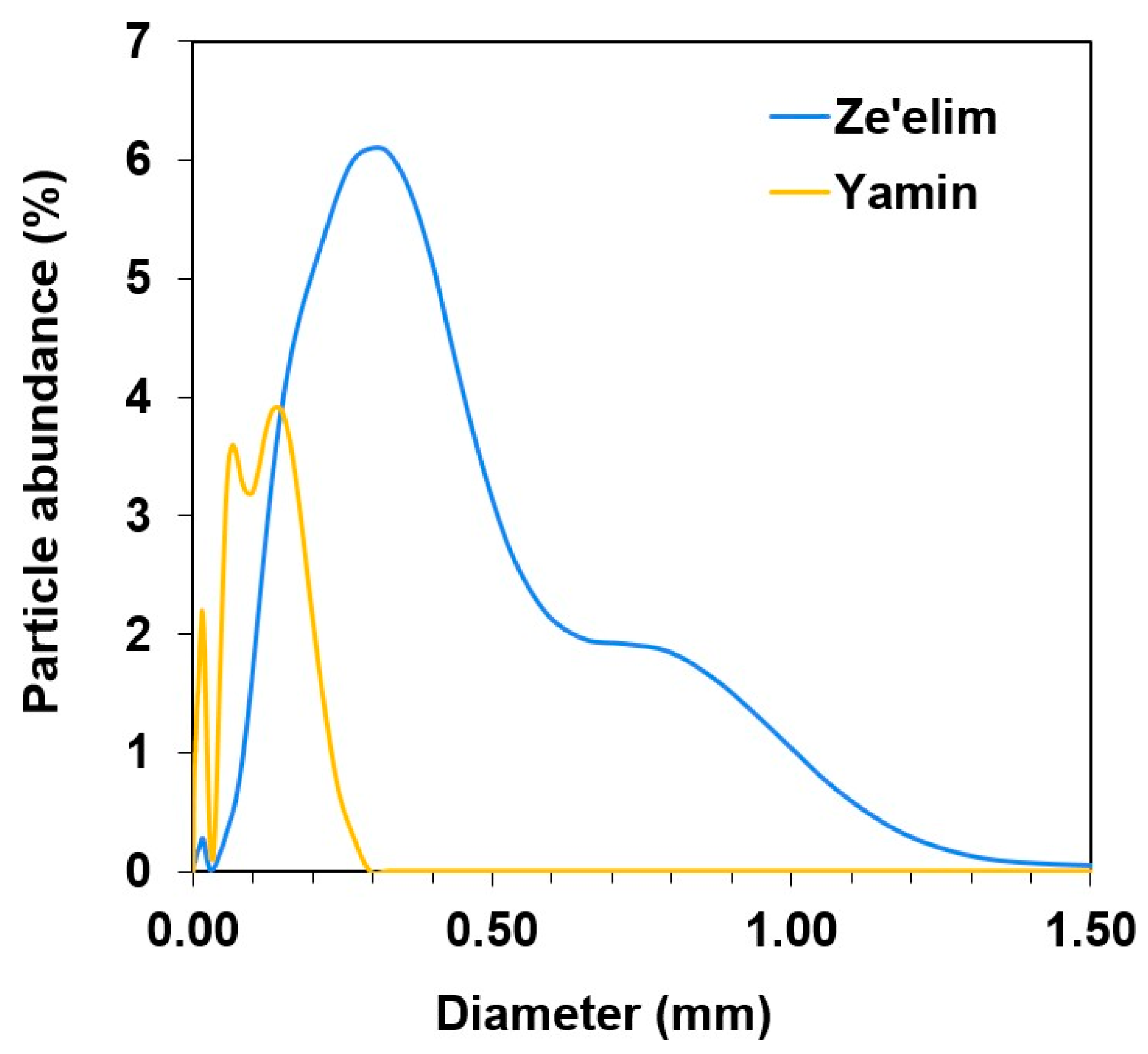
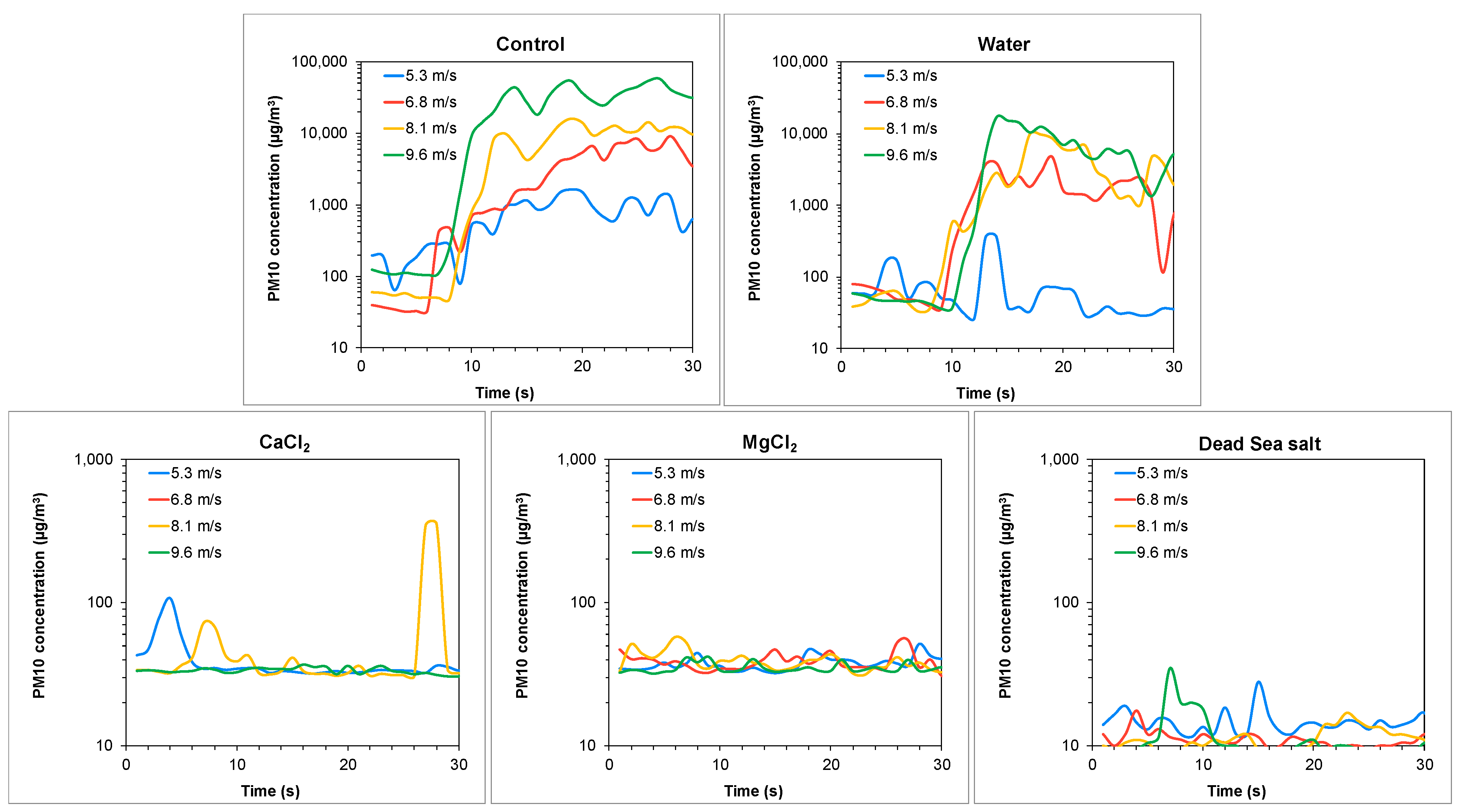
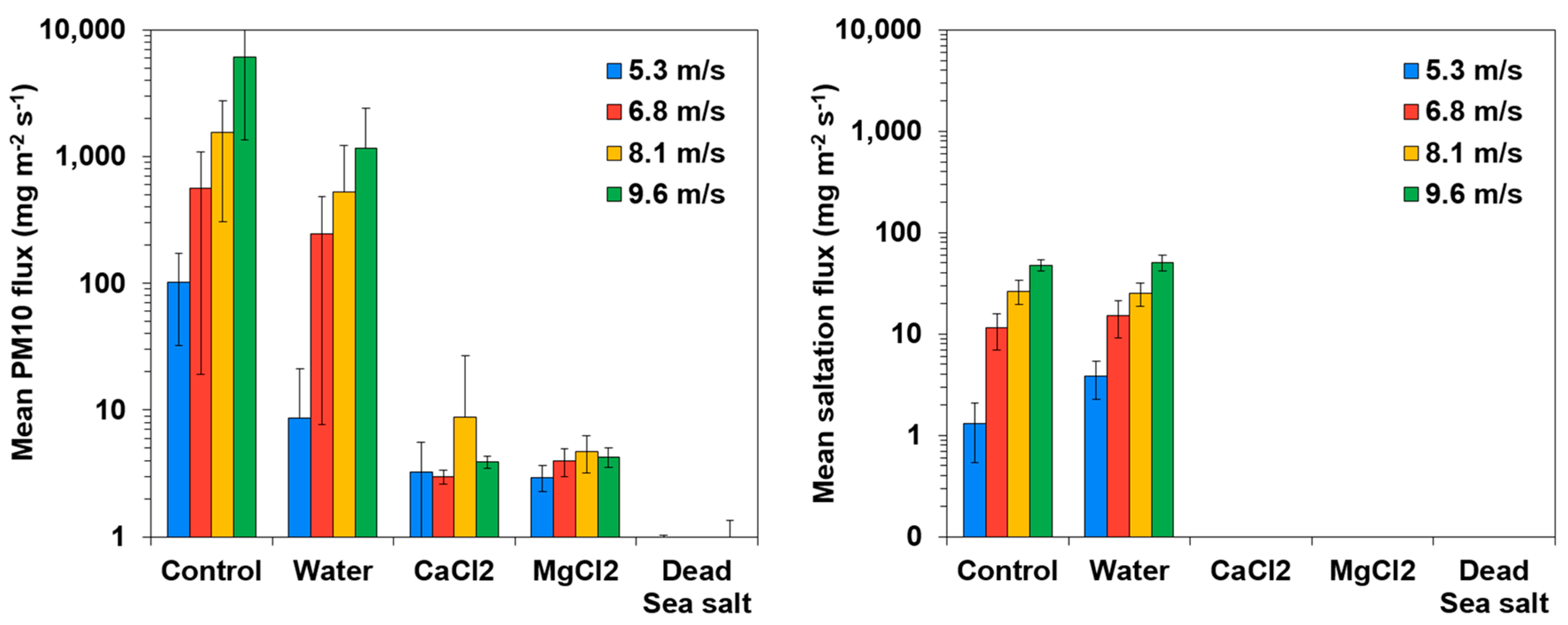

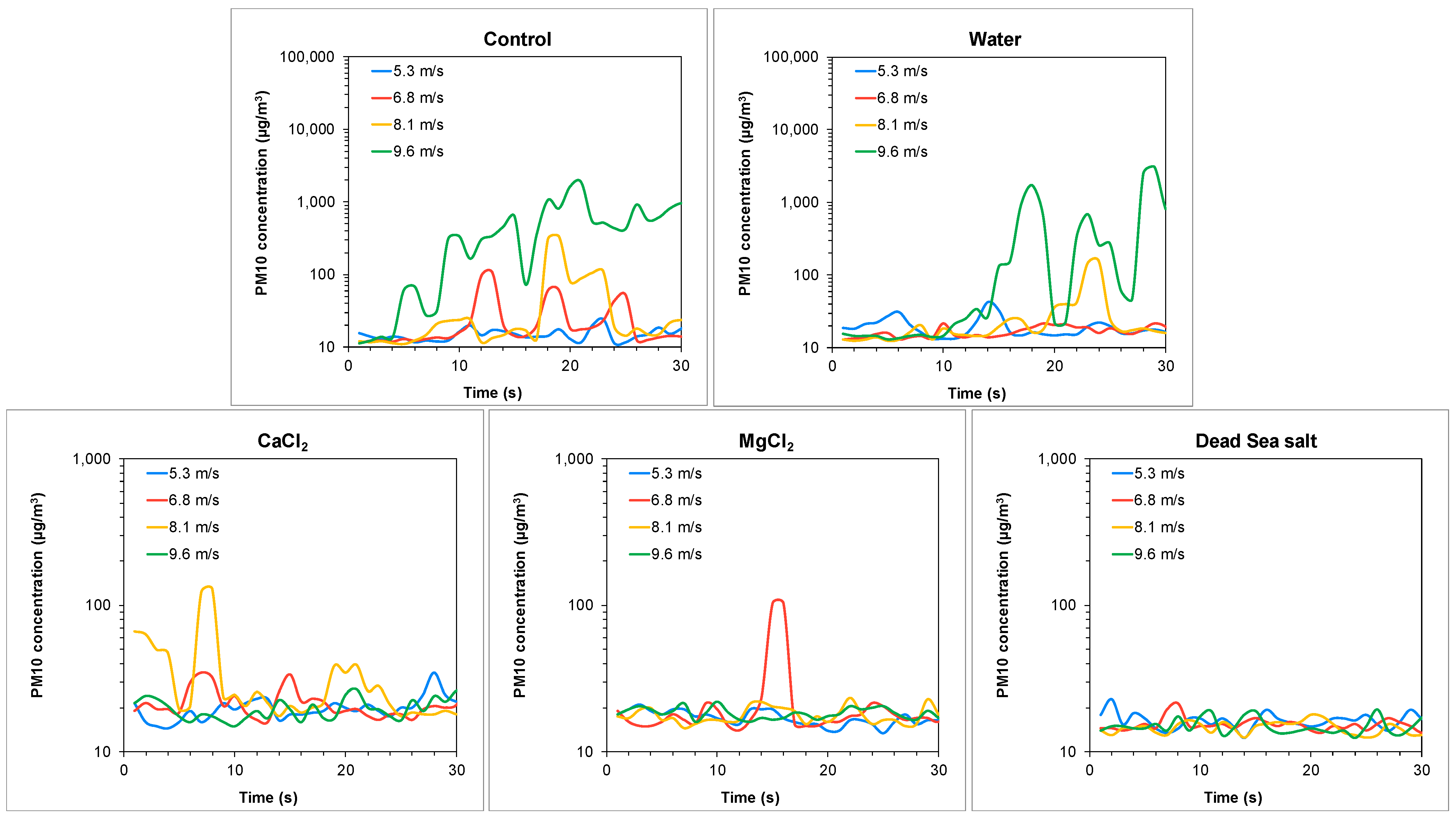
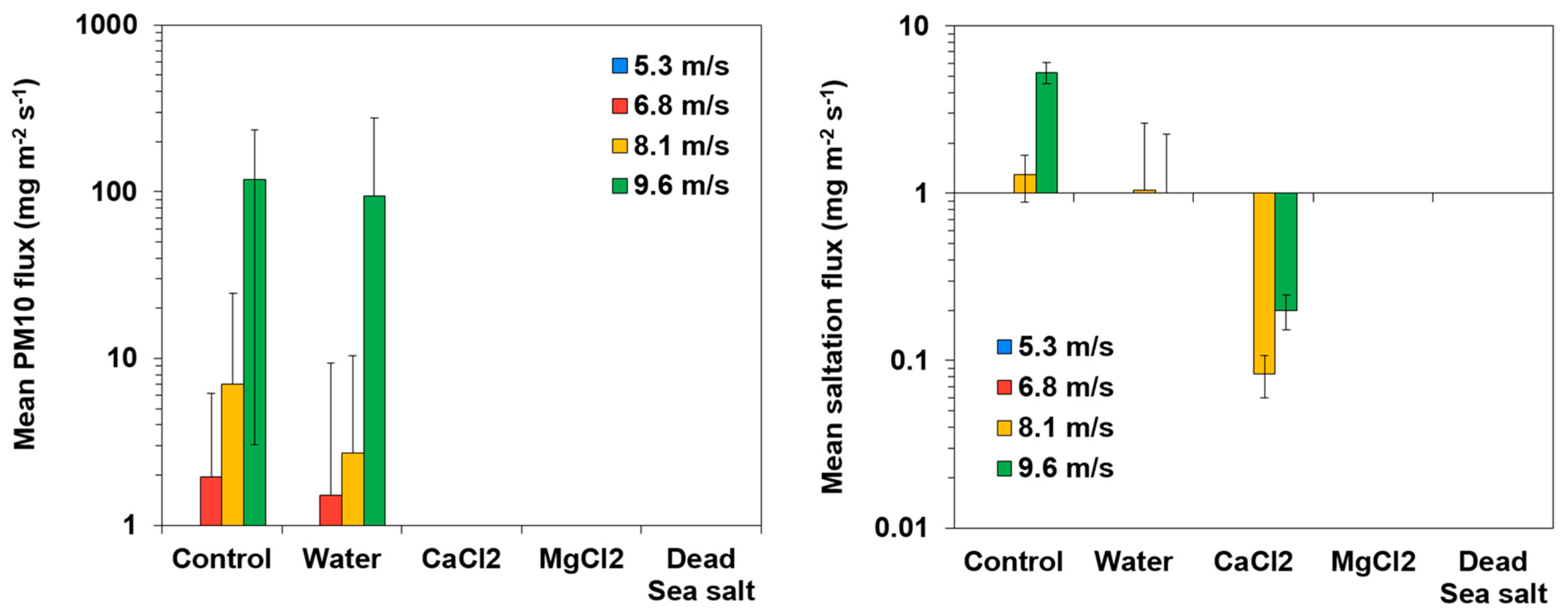

| Ion/Element | Stabilization Material | ||
|---|---|---|---|
| CaCl2 | MgCl2 | Dead Sea Salt Water | |
| Na+ | - | - | 8700 |
| K+ | - | - | 13,600 |
| Ca++ | 127,000 | - | 28,800 |
| Mg++ | - | 76,600 | 74,000 |
| Cl− | 223,000 | 223,000 | 291,000 |
| Br− | - | - | 8400 |
| Soil | Non-Stabilized Control (Untreated) | Tap Water | Stabilization Material | ||
|---|---|---|---|---|---|
| CaCl2 | MgCl2 | Dead Sea Salt | |||
| Yamin | A | B | C | C | C |
| Ze’elim | A | B | C | C | C |
| Compound | Ze’elim Soil (wt%) | Yamin Soil (wt%) |
|---|---|---|
| SiO2 | 89 | 84 |
| Al2O3 | 5 | 3 |
| CaO | 2 | 8 |
| Fe2O3 | 2 | 2 |
| K2O | 1 | 1 |
| SiO2 | 89 | 84 |
| Properties | Ze’elim Soil (wt%) | Yamin Soil (wt%) |
|---|---|---|
| pH | 7.9 | 7.8 |
| Water content (wt%) | <1 | <1 |
| Total organic content (wt%) | <0.3 | <0.3 |
| Size Fraction | Ze’elim Soil (%) | Yamin Soil (%) | |
|---|---|---|---|
| Clay (<0.002 mm) | 1 | 7 | |
| Silt (0.002–0.063 mm) | 6 | 51 | |
| Sand | Fine (0.063–0.25 mm) | 37 | 41 |
| Medium (0.25–0.5 mm) | 39 | 1 | |
| Coarse (0.5–2.0 mm) | 17 | 0 | |
| PM10 (<0.01 mm) | 3 | 28 | |
| Wind Velocity/ Treatment | 5.3 m/s | 6.8 m/s | 8.1 m/s | 9.6 m/s |
|---|---|---|---|---|
| Tap Water | 92% | 56% | 66% | 81% |
| CaCl2 | 97% | 99% | 99% | 100% |
| MgCl2 | 97% | 99% | 100% | 100% |
| Dead Sea salt | 100% | 100% | 100% | 100% |
| Wind Velocity/ Treatment | 5.3 m/s | 6.8 m/s | 8.1 m/s | 9.6 m/s |
|---|---|---|---|---|
| Tap Water | 0% | 0% | 4% | 0% |
| CaCl2 | 100% | 100% | 100% | 100% |
| MgCl2 | 100% | 100% | 100% | 100% |
| Dead Sea salt | 100% | 100% | 100% | 100% |
| Wind Velocity/ Treatment | 5.3 m/s | 6.8 m/s | 8.1 m/s | 9.6 m/s |
|---|---|---|---|---|
| Tap Water | NA 1 | 22% | 61% | 21% |
| CaCl2 | NA 1 | 100% | 100% | 100% |
| MgCl2 | NA 1 | 100% | 100% | 100% |
| Dead Sea salt | NA 1 | 100% | 100% | 100% |
| Wind Velocity/ Treatment | 5.3 m/s | 6.8 m/s | 8.1 m/s | 9.6 m/s |
|---|---|---|---|---|
| Tap Water | NA 1 | NA 1 | 19% | 81% |
| CaCl2 | NA 1 | NA 1 | 94% | 96% |
| MgCl2 | NA 1 | NA 1 | 100% | 100% |
| Dead Sea salt | NA 1 | NA 1 | 100% | 100% |
Publisher’s Note: MDPI stays neutral with regard to jurisdictional claims in published maps and institutional affiliations. |
© 2022 by the authors. Licensee MDPI, Basel, Switzerland. This article is an open access article distributed under the terms and conditions of the Creative Commons Attribution (CC BY) license (https://creativecommons.org/licenses/by/4.0/).
Share and Cite
Raveh-Amit, H.; Sharon, A.; Katra, I.; Stilman, T.; Serre, S.; Archer, J.; Magnuson, M. Limiting Wind-Induced Resuspension of Radioactively Contaminated Particles to Enhance First Responder, Early Phase Worker and Public Safety—Part 1. Appl. Sci. 2022, 12, 2463. https://doi.org/10.3390/app12052463
Raveh-Amit H, Sharon A, Katra I, Stilman T, Serre S, Archer J, Magnuson M. Limiting Wind-Induced Resuspension of Radioactively Contaminated Particles to Enhance First Responder, Early Phase Worker and Public Safety—Part 1. Applied Sciences. 2022; 12(5):2463. https://doi.org/10.3390/app12052463
Chicago/Turabian StyleRaveh-Amit, Hadas, Avi Sharon, Itzhak Katra, Terry Stilman, Shannon Serre, John Archer, and Matthew Magnuson. 2022. "Limiting Wind-Induced Resuspension of Radioactively Contaminated Particles to Enhance First Responder, Early Phase Worker and Public Safety—Part 1" Applied Sciences 12, no. 5: 2463. https://doi.org/10.3390/app12052463
APA StyleRaveh-Amit, H., Sharon, A., Katra, I., Stilman, T., Serre, S., Archer, J., & Magnuson, M. (2022). Limiting Wind-Induced Resuspension of Radioactively Contaminated Particles to Enhance First Responder, Early Phase Worker and Public Safety—Part 1. Applied Sciences, 12(5), 2463. https://doi.org/10.3390/app12052463






